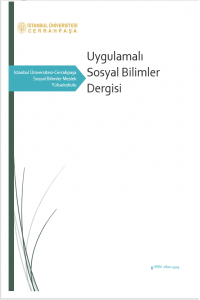AN ECONOMETRIC ESSAY FOR THE ASYMMETRIC VOLATILITY CONTENT OF THE PORTFOLIO FLOWS: EGARCH EVIDENCE FROM THE TURKISH ECONOMY
Portföy Akımları, Bakışımsız Volatilite, EGARCH
AN ECONOMETRIC ESSAY FOR THE ASYMMETRIC VOLATILITY CONTENT OF THE PORTFOLIO FLOWS: EGARCH EVIDENCE FROM THE TURKISH ECONOMY
___
- AGENOR, P.-R., C.J. MCDERMOTT, and E.M. ÜÇER; (1997), “Fiscal Imbalances, Capital Inflows, and the Real Exchange Rate: The Case of Turkey”, IMF Working Paper, No. 987/1.
- AKÇORAOĞLU, A.; (2000), “International Capital Movements, External Imbalances and Economic Growth: The Case of Turkey”, Yapı Kredi Economic Review, 11/2, pp. 21-36.
- ALPER, C.E. and İ. SAĞLAM; (2002), “The Transmission of a Sudden Capital Outflow: Evidence from Turkey”, Eastern European Economics, 39/2, 29-48.
- BİÇER, G. and A.E. Yeldan; (2002), “Patterns of Financial Capital Flows and Accumulation in the Post-1990 Turkish Economy”, Canadian Journal of Development Studies, 24/2, 250-65.
- BOLLERSLEV, T.; (1986), “Generalized Autoregressive Conditional Heteroskedasticity”, Journal of Econometrics, 31, 307-27.
- BOLLERSLEV, T. and J.M. WOOLDRIDGE; (1992), “Quasi-maximum Likelihood Estimation and Inference in Dynamic Models with Time Varying Covariances”, Econometric Reviews, 11, 143-72.
- CBRT; (2006), Inflation Report, No. 2006-IV.
- CELASUN, O., C. DENİZER, and D. HE; (1999), “Capital Inflows, Macroeconomic Management, and the Financial System: The Turkish case, 1989-97”, World Bank Working Paper, No. 2141.
- ÇULHA, A.; (2006), “A Structural VAR Analysis of the Determinants of Capital Flows into Turkey”, CBRT Research and Monetary Policy Department Working Paper, No. 06/05.
- DING, Z., C.W.J. GRANGER, and R.F. ENGLE; (1993), “A Long Memory Property of Stock Market Returns and a New Model”, Journal of Empirical Finance, 1, 83-106.
- ENDERS, W.; (2004), Applied Econometric Time Series, 2.ed., John Wiley & Sons, Inc.
- ENGLE, R.F.; (1982), “Autoregressive Conditional Heteroskedasticity with Estimates of the Variance of U.K. Inflation”, Econometrica, 50, 987-1008.
- ENGLE, R.F., D.M. LILIEN, and R.P. ROBINS; (1987), “Estimating Time Varying Risk Premia in the Term Structure: The ARCH-M Model”, Econometrica, 55, 391-407.
- GLOSTEN, L.R., R. JAGANATHAN, and D. RUNKLE; (1993), “On the Relation between the Expected Value and the Volatility of the Normal Excess Return on Stocks”, Journal of Finance, 48, 1779-1801.
- INTERNATIONAL MONETARY FUND; (2006), World Economic Outlook, September.
- INTERNATIONAL MONETARY FUND; (2008), World Economic Outlook, October.
- KİRMANOĞLU, H. and Ö. ÖZÇİÇEK; (1999), “The Effect of Short-term Capital Inflow on the Turkish Economy”, Yapı Kredi Economic Review, 10/1, 27-34.
- NELSON, D.B.; (1991), “Conditional Heteroskedas- ticity in Asset Returns: A New Approach”, Econometrica, 59/2, March, 347-70.
- ZAKOIAN, J.M;. (1994), “Threshold Heteroskedastic Models”, Journal of Economic Dynamics and Control, 18, 931-44.
- Başlangıç: 2007
- Yayıncı: İstanbul Üniversitesi-Cerrahpaşa
SÜRDÜRÜLEBİLİR KALKINMA HEDEFİ ÇERÇEVESİNDE TÜRKİYE'NİN RÜZGAR ENERJİSİ POTANSİYELİNİN YERİ VE ÖNEMİ
THE RELATION BETWEEN AGE STRUCTURE AND SAVING RATE OF TURKEY: 1968-2006
Nergis Nalân ALTINTAŞ, Nalan YAKAR
İMKB'NİN LATİN AMERİKA BORSALARIYLA İLİŞKİSİ ÜZERİNE ÇOK DEĞİŞKENLİ GARCH MODELLEMESİ
ÜNİVERSİTE GENÇLİĞİNİN KAZANÇ SÖYLEMİ
AVRUPA BİRLİĞİ EMİSYON TİCARETİ PROGRAMI VE CO2 FİYATINI BELİRLEYEN FAKTÖRLER
